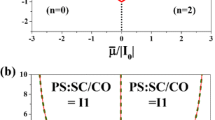Abstract
We investigate theoretically the influence of impurity polarization on the superconducting transition temperature of superconductors containing magnetic impurities. From previous theoretical work it is known that the pair-breaking effect of magnetic impurities is reduced when the impurity spins are fixed by an internal field. This spin-dynamic effect is studied in detail on two models of the magnetic state of the system based on a mean field theory. In some cases the critical concentration of magnetic impurities that destroys superconductivity atT=0 is increased, but we find that the polarization energy of the magnetic impurities must be very large compared to the gap energy of the pure superconductor in order to increase the critical impurity concentration by the factor (S+1)/S reported in the literature. We conclude that the anomalous dependence of the superconducting transition temperature on the concentration of magnetic impurities observed on some dilute alloys with rare-earth impurities can only be attributed to spin-dynamic effects if extraordinary strong polarizing forces between the magnetic impurities exist.
Similar content being viewed by others
References
The first experiments were performed by Hilsch's group in Göttingen [references can be found in the article of K. Schwidtal,Z. Physik 158, 563 (1960)] and by Matthias and co-workers [B. T. Matthias, H. Suhl, and E. Corenzwit,Phys. Rev. Letters 1, 92 (1958);1, 449 (1958)].
A. A. Abrikosov and L. P. Gorkov,Zh. Eksperim. i Teor. Fiz. 39, 1781 (1960) [English transl.:Soviet Phys.—JETP 12, 1243 (1961)].
R. A. Hein, R. L. Falge, B. T. Matthias, and E. Corenzwit,Phys. Rev. Letters 2, 500 (1959).
J. E. Crow and R. D. Parks,Phys. Letters 21, 378 (1966); K. Yasukochi, Y. Kuwasawa, and K. Sekizawa,Phys. Letters 28A, 12 (1968).
A. M. Toxen, P. C. Kwok, and R. J. Gambino,Phys. Rev. Letters 21, 792 (1968).
R. P. Guertin, J. E. Crow, and R. D. Parks,Phys. Rev. Letters 16, 1095 (1966); D. K. Finnemore, D. C. Hopkins, and P. E. Palmer,Phys. Rev. Letters 15, 891 (1956).
L. P. Gorkov and A. I. Rusinov,Zh. Eksperim. i Teor. Fiz. 46, 1363 (1964) [English transl.:Soviet Phys.—JETP 19, 922 (1964)].
K. H. Bennemann,Phys. Rev. Letters 17, 438 (1966).
F. Takano,Progr. Theoret. Phys. 36, 1095 (1966).
M. W. Klein and R. Brout,Phys. Rev. 132, 2412 (1963).
V. Ambegaokar and A. Griffin,Phys. Rev. 137A, 1151 (1965).
W. Brenig and W. Götze,Phys. Letters 27A, 276 (1968).
A. A. Abrikosov,Physics 2, 5 (1965);2, 61 (1965).
P. Fulde and K. Maki,Phys. Rev. 141, 275 (1965).
Author information
Authors and Affiliations
Additional information
Supported in part by Deutsche Forschungsgemeinschaft.
Rights and permissions
About this article
Cite this article
Keller, J., Benda, R. On the problem of superconductors containing polarized magnetic impurities. J Low Temp Phys 2, 141–155 (1970). https://doi.org/10.1007/BF00628108
Received:
Issue Date:
DOI: https://doi.org/10.1007/BF00628108




